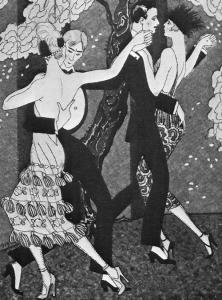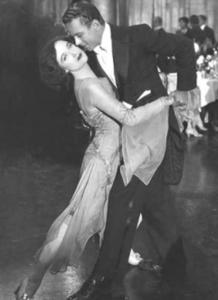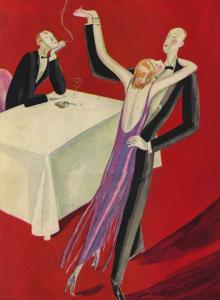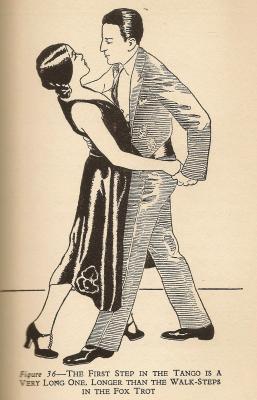- Historical Dance
- Jazz Age Social Dancing ("The Modern Dances")
- 0. The Essentials of Jazz Age Ballroom Dancing
- 1. Foxtrot Part 1: The Jazz Age Foxtrot
- 2. Youth Dancing in the Jazz Age
- 3. The Jazz Age Waltz
- 4. The Jazz Age Tango
- 5. 1930s Rumba
- 6. 1930s Samba
- 7. 1930s Conga
- 8. Bal Musette: Parisian Dance of the Jazz Age
- 9. Dancing in Weimar Berlin
- Dancing Made Easy - 1922
- Film Library - Jazz Age Dance
- Historical Dance Films posted to Pinterest
- Jazz Age Dance - Apologia
- Jazz Age Dance Image Collection
- Jazz Age Lead and Follow
- Places to Dance in Southern California in the Jazz Age
- Sampler of Jazz Age Dance Holds
- The Pathé Historical Dance Collection: 1920s-40s
- Ragtime Dance - the One Step
- Regency Dance
- Victorian Dance
- Jazz Age Social Dancing ("The Modern Dances")
4. The Jazz Age Tango
 The Jazz Age Tango, perhaps even more than the Foxtrot, runs afoul of modern notions. Tango is a dance that is passionately practiced by many dancers in our present day, who have very clear ideas of what is, and is not, TRUE Tango - and what constitutes TRUE Tango is often a point of passionate disagreement among them. Many of them, of what ever camp, would look at what was danced in the '10s, '20s and '30s and pronounce that what those people were doing was, most decidedly, not a proper Tango.
The Jazz Age Tango, perhaps even more than the Foxtrot, runs afoul of modern notions. Tango is a dance that is passionately practiced by many dancers in our present day, who have very clear ideas of what is, and is not, TRUE Tango - and what constitutes TRUE Tango is often a point of passionate disagreement among them. Many of them, of what ever camp, would look at what was danced in the '10s, '20s and '30s and pronounce that what those people were doing was, most decidedly, not a proper Tango.
The early Tango certainly lacked the theatricality which is so much a part of the current general public perception of the Tango. The obligatory scissors kicks were almost completely absent, and the dramatic poses were not nearly so widespread nor dramatic. As with the Foxtrot,it was a friendly social dance, with focus on partner interaction rather than on the audience pleasing dramatic effect that is so visible today - as so often happens today, the "Exhibition" style of a dance comes to be perceived as the "correct" form of that dance.
In addition, the music itself had a different character, especially in Europe, being smoother, mellower and less staccato than modern Tango music tends to be.
To be fair, the more well-informed of the time spoke disparagingly of the popular European/North American Tango - and were universally ignored.
"Many incorrect words and phrases have come, by common usage, to be recognized as correct, just as slang words have been converted into good English by the same process.
This is true of the Tango. What has been taught and danced … and is still being danced as the Tango, is, in reality, not the Tango, but has been classified by the best authorities as the One Step...
I therefore bow to common usage and teach the One Step as the Tango, because it is the dance which the majority of people recognize as the Tango." Walker, The Modern Dances, 1914
(For videos of actual Argentine Tango of the 1930s, scroll to the bottom of this page. For French Tango, click here)
The Tango burst onto the international scene in 1912 when Parisians took up and modified what was brought to them by Argentine visitors. In Paris, it became a sexy dance to be danced by fashionable modern people who rejected the stuffy manners and morality of the Victorian era, and it spread all over Europe and North America to an audience that was hungry for innovation and dances that gave a sense of the modern.
Its popularity in the Jazz Age was secured by Rudolf Valentino's steamy performance in the 1921 film "Four Horsemen of the Apocalypse" 
The Jazz Age Tango, like every other ballroom dance of the period, was just walking interspersed with "variations". This walking however, had a distinctly Tango spirit and attitude with the knees a bit more bent and a sense of drama - at least if you were doing it properly. Further, a Tango step tended to be heel-first, while the Foxtrotter tended to move on the balls of his feet. However, you could (and they did) just Fox Trot to a Tango, just like you could Fox Trot to pretty much anything.
Most of the variations you could do in the other dances, you could also do in Tango, with suitable Tango styling. An important element of Tango is its variability. Much of Tango's character comes from the fact that you can vary your speed from slow to fast to standing absolutely still, or walking step-step-step-pause.... The most distinctive and frequent aspect of this is the pause. Tangoists paused a lot. This pause was usually for a single beat, when the dancers would bring their feet together at the end of a phrase and then resume (left-right-left-together). It could also involve a pose, held for several beats.
There were also some Tango-specific variations, which I won't describe here, but will leave to my videos to demonstrate.
 Like the Foxtrots and Waltzes of the time, the dancers seldom left their close embrace. Modern Tango often involves the partners separating, flinging heels around and assuming very dramatic attitudes which would not be seen in the more restrained Tango of the Jazz Age ballroom. Indeed, the broad, theatrical moves that are so much associated in the modern mind with Tango were present in the Jazz Age, but were the purview of exhibition dancers, such as might be featured in a nightclub floor show; while the social dancers kept it simple.
Like the Foxtrots and Waltzes of the time, the dancers seldom left their close embrace. Modern Tango often involves the partners separating, flinging heels around and assuming very dramatic attitudes which would not be seen in the more restrained Tango of the Jazz Age ballroom. Indeed, the broad, theatrical moves that are so much associated in the modern mind with Tango were present in the Jazz Age, but were the purview of exhibition dancers, such as might be featured in a nightclub floor show; while the social dancers kept it simple.
Even then, the theatrical, exhibition Tango dancers of the Jazz Age tended to dance with a different spirit than modern exhibition Tango. Jazz Age exhibition Tango tended to emphasize intimacy, sensuality and grace rather than violent, staccato moves.
"The tango is 2/4; 2 counts to a measure, 4 counts to a phrase of movement. As you see, the tango is similar to a very slow Fox Trot.
There are three different positions that may be taken in tango steps:
1. Where partners are directly facing each other, the girl in front of the man.
2. Where the girl faces the man slightly to the right side of him, her right shoulder in front of his right shoulder, hands in regular position, and
3. Where both face the same direction, girl's left side beside man's right side, hands in regular position."
(Modern Ballroom Dancing, Ray, 1930)
One of the elements I find most interesting is that while the dance manuals of the time describe signature Tango moves like the Corte or the Ocho, they are very seldom in evidence in films of dancers of the time. Most Jazz Age Tangoists seem perfectly happy with a very simple, unadorned, intimate and decidedly unflashy dance.
- Next: The Rumba
This first one is a pastiche of Tango scenes from American, French and German films of the late '20s and early '30s.
George Raft and Marie Windsor dance the Tango in "Outpost in Morocco" from 1949. Some nice overhead shots that give a very good view of George and Marie's unadorned Tango style as well as those of their fellow dancers.
Here is a Dutch dance teacher from 1930 showing his interpretation of the Tango.
Real Argentine Tango
And here's a wonderful pastiche of what they were doing in old Argentina. I have extracted all the Tango scenes from the 1933 Argentine film "Tango!". While there are a few examples of showy moves, like the Northern Hemisphere Tangoists, the dance is mostly simple, unadorned and intimate
I have extracted the two Tango scenes from the 1934 Argentine film Questa Abajo with Carlos Gardel
